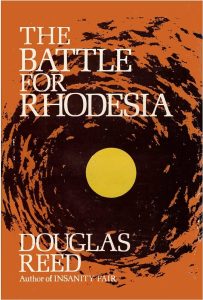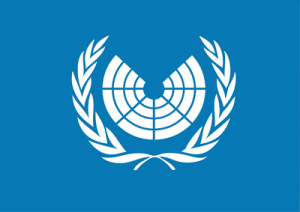The Battle for Rhodesia
by Douglas Reed
Chapter Twenty Three
THE WORLD OF WAPWAG
In this century we have seen empires and kingdoms, monarchs and princes, presidents and republics crumble and go. Each step was supposed to lead to something “new” and better, and each was followed by deterioration. No pattern of improvement, of a rising brotherhood of man, emerged from it all. The only pattern, if such it can be called, was that of destroying old things without putting better ones in their place: witness the world today.
However, one discernible thread ran through the disorderly process. It was that of world revolution leading to despotic world government. For this reason the process could not stop, any more than a stone rolling downhill. It had to come to fruition or finally fail, and this moment of decision now bears down on us all.
Students much more erudite than I, who have examined this matter, find that their search takes them into olden times, indeed, into ancient ones. Let us here take it up at the point where it became visible in our recent world, and carry the story, briefly, through to this day.
It all began then, for our purpose, with the chance discovery (as accidental as that of Mr. Whitaker Chamber’s Hiss-incriminating “pumpkin papers”) by the Royal Bavarian Government in 1787 of the documents of a secret society, the Illuminati of Adam Weishaupt, a university professor. Obviously this plan for world revolution (the papers can be read by any who care to undertake the research) cannot have sprung, as by demoniac birth, from the mind of one man: a long history of organisation and conspiracy clearly preceded it.
However, these documents for the first time proved the existence of the revolutionary conspiracy which we know today as communism (it has had various other names). It is identifiable from them as the same thing, for all the aims and methods are there: the cell system of organization (only when the papers were published did most of the Illuminates know that Weishaupt existed or was the head): the use of aliases (cover names); the employment of “useful fools” (high clerics and princes, believing themselves to be of “Liberal” mind, were among its members, and a Duke of Brunswick, when he saw the real aims, made anguished confession of his duplicity); the denunciation of parents; the use of ciphers, poisons and explosives; and all the rest. The aims were the eradication of religion, family, nations and the establishment of world government.
The Illuminati played a large part in the secret societies behind the French Revolution and then extended their influence to America, so that George Washington expressed himself “fully satisfied that the doctrines of the Illuminati have spread to the United States”. They were exposed by three writers, Messrs. Barruel, Robison and Morse and one of George Washington’s last acts was to thank Mr. Morse for his work, “the dissemination of which would be useful, if spread through the community” (Mr. Whitaker Chambers, in 1939, received a presidential recommendation to ‘go jump in the lake” when he offered his revelations). I was surprised to find how far control of the press in America had gone even in that time: Messrs. Barruel, Robison and Morse were “smeared” out of literary existence.
The revolutionary conspiracy then went underground for a time and after Napoleon’s fall emerged behind a Christian cover-name, calling itself The Holy Alliance. It was perceived to be an attempt at a supernational dictatorship and that name faded out, but the subversive work continued and appeared in France again towards the mid-century under one Louis Blanc, who worked for “World Revolution” and the super-State.
Probably few people in Texas, even today, ever heard of Louis Blanc, but thirty years later still a young Texan, one Edward Mandell House, was absorbing ideas “reminiscent of Louis Blanc and the revolutionaries of 1948” (the editor of his Papers).
This “Colonel” House, when the new century broke, became one of the group of men who chose a little-known university professor, one Woodrow Wilson, to be candidate for the Presidency. Mr. House boasted (his Papers) that he infused ideas into other men’s minds; the ideas, as has been seen, were those of Louis Blanc.
At that time Mr. House’s “ideas” about the total shape of the grand conspiracy were limited. The hero of his novel of 1912 (when Mr. Wilson became president) was an American dictator who wished to bring about “an international grouping or league of powers founded on Anglo-Saxon solidarity” (a very different thing from what later developed). Nevertheless, the central idea was there: some body above nations.
Mr. House was virtually president during Mr. Wilson’s two terms (the Papers) and thus wielded the presidential power. He discussed the great “idea” with the ailing British Foreign Minister, Sir Edward Grey, and the shape of it changed again. The two men now talked about some super-national body that should combine against States which committed inhumane acts in war. The central idea continued: some authority over nations. Sir Edward fell into the trap and then proposed “some league of nations backed by force”. Later Sir Edward, with the familiar Liberal dislike of words revealing intention, backed away from “force” and substituted the genteel-sounding “sanctions”.
But not for long. In 1916 Mr. House prompted President Wilson publicly to support the plan for “some league of nations” before a body then newly-formed: The League To Enforce Peace. Thus the Plan became clearer: peace was to be enforced by war. Lord Robert Cecil demurred at that point, reminding Mr. House that the Holy Alliance too began as “a league to enforce peace” but in fact became “a league to uphold tyranny” (today’s demonstrable concept).
Then Mr. House set up a body called “The Inquiry” to draft the plan of “a new world order”. The drafters were three little-known persons: a Dr. Sidney Mezes (Mr. House’s brother-in-law), a Dr. Isaiah Bowman, and a Mr. Walter Lippman, (whom I believe to be still with us). In all this President Wilson played no part beyond giving his public blessing to The League To Enforce Peace: Mr. House says that the President “never seriously studied” the matter and was not the author of the League of Nations, with which the First War ended. Nevertheless, the obedient Mr. Wilson then insisted on a new “general association of nations”, so that, out of all the earlier spadework behind the scenes, came the League of Nations of 1919.
That League collapsed in 1939 and throughout the Second War the leading men of the West continued, as if possessed, to declare that the creation of another super-national body must be a foremost aim of victory. During that war the grand design was unremittingly pursued and again persons behind the scenes proved in the event to know more about the outcome than presidents, prime ministers and the public masses.
For instance, a Mr. Moritz Gomberg was presumably unknown to the multitudes embroiled when in 1942 he popped up with a “Group for a New World Order” and published a map showing the rearrangement of the globe. He foresaw that at the war’s end the communist empire would extend from the Pacific to the Rhine (Berlin is not far from the Rhine), that a Hebrew State should be set up in Palestine (which happened), that the remnant of Western Europe should disappear in a “United States of Europe” (something which is now being actively pursued), and that the African continent should become a “Union of Republics” (it is becoming a shambles, the same thing).
Mr. Churchill then seems to have become aware that all was not going as he thought the war’s purpose to be, and remonstrated: “Let me make this clear, in case there should be any mistake about it in any quarter. We mean to hold our own. I have not become the King’s First Minister in order to preside over the liquidation of the British Empire … Here we are and here we stand, a veritable rock of salvation in this drifting world”. (His then son-in-law, twenty years later, said “We have lost the will to govern”, according to Sir Roy Welensky).
The war ended. The United Nations was ushered into being by Mr. Alger Hiss and twenty years have shown what it has done and yet might do. By 1953 the One-Worlders, waiting for the sunrise, evidently thought that the great day was at hand, and also the instrument, the United Nations.
In that year the full shape of the Grand Design, the Master Plan at length emerged. This, in our current idiom, was It. In this document the world might see just what awaited it, if all the “ideas” took shape. Here is no longer any vague talk of some league to enforce something. Here is the Grand Design worked out in detail, so that any man can see just how it would affect him, his family, his future and his world. This is the plan which, in my estimation, our One-Worlders aspire to carry through under cover of another war, if the American president of the day can be prevented from saying: “Veto”.
It came from a body calling itself The World Association of Parliamentarians for World Government, or WAPWG. To make this unutterable hieroglyph utterable, I will borrow a vowel and call it henceforth WAPWAG. It is, or was, but one of the un-numerable “front” bodies working towards the revolutionary end. However, this one produced, at its second conference in 1952, the Master Plan. It deserves a chapter to itself.
Come, gentle reader, and consider Wapwag’s Master Plan for the world …
* * *
If you would like to read the beginning and the end of this account by Douglas Reed, visit archive.org and download Ben Steigmann’s package, “TheBattleForRhodesia”. Take note, however, that the mention of Moritz (Maurice) Gomberg and his “Group for a New World Order”, quoted above, is the only mention in this book.
For more on “WAPWAG”, see Wikipedia, which attributes the founding of WAPWAG to Henry Charles Usborne (1909-1996), and says:
This mutating organization sounds very much like today’s UNPA, the Campaign for a United Nations Parliamentary Assembly, whose goal is world government. It boasts an international roster of members of national legislatures and other notables who advocate for a one-world government. The UNPA has a timeline of “milestones“, tracing the origins of the forced march to world government from the French Revolution through the two world wars.“the World Association of Parliamentarians for World Government (WAPWG)[6] in 1947, later renamed the World Parliament Association (WPA)[5] which as All Party Parliamentary Group for World Governance (APPGWG) counts today 167 members of APPGWG, and meets regularly to provide a forum for debate on global governance issues in the British Parliament.”
See a list of “All Individual Signatories” in the Wayback Machine on November 24, 2023.
nt
Justin Trudeau, while a Member of Parliament for Canada, signed the UNPA on 2010-07-21. It should be noted that as far as Canada is concerned, this is high treason, tantamount to advocating the overthrow of the Canadian Parliament, by attempting to place another institution above it.
You can search the UNPA for the names of signatories from all countries.
– 30 –

